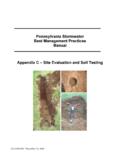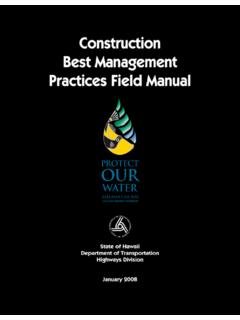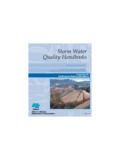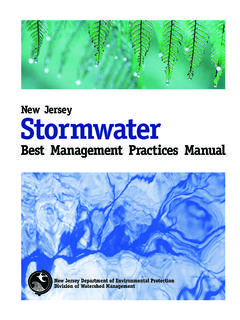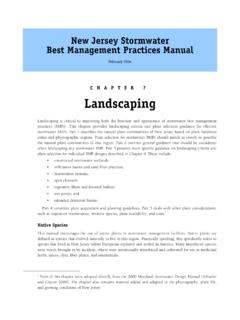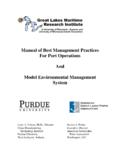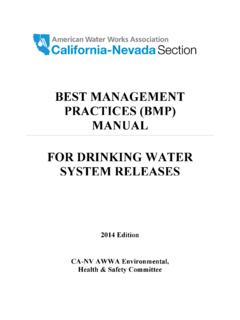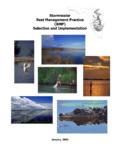Transcription of CHAPTER 9 STORMWATER BEST MANAGEMENT PRACTICES (BMPs)
1 CHAPTER 9 STORMWATER best MANAGEMENT PRACTICES (BMPs) NOTE: All questions and comments should be directed to the Drainage Specialist, Design Support Area. Revised January 2006 STORMWATER best MANAGEMENT PRACTICES (BMPs) 9-2 CHAPTER Table of Contents Introduction/Purpose 9-3 Non-Point Source Pollution Overview 9-3 Soil Erosion and Sedimentation Control 9-4 Definitions 9-6 Policy and Design Criteria 9-7 Federal Policy 9-7 AASHTO Policy 9-7 MDOT Policy 9-7 Design Guidance and Procedure 9-9 BMP Selection Process 9-9 MDOT Goals 9-10 Project Delivery Steps 9-11 Location Issues 9-12 Excluded Projects 9-12 MDOT-Approved BMPs 9-13 Summary List for BMP Selection 9-13 BMP
2 Descriptions and Applications 9-18 References 9-35 Weblinks 9-36 Appendices 9-A Symbols and Acronyms 9-A-1 9-B Cost List for MDOT-Approved BMPs 9-B-1 Tables 9-1 List of MDOT-Approved BMPs 9-14 STORMWATER best MANAGEMENT PRACTICES (BMPs) 9-3 INTRODUCTION/PURPOSE The purpose of this CHAPTER is to introduce STORMWATER best MANAGEMENT PRACTICES (BMPs) for use in MDOT operations, and to give a brief overview of how they can be used to improve water quality. Some MDOT publications call out for BMP elements to be "Designed by the Engineer." This CHAPTER will give additional design information for references made to "the engineer" within MDOT s Soil Erosion and Sedimentation Control (SESC) manual .
3 It is not the intent of this CHAPTER to provide an all-encompassing list of potential BMPs to be used by MDOT. BMPs in other MDOT publications can and should be referenced by the engineer. Note the numbers (E&S-#) of standard plan R-96-Series following titles of BMPs discussed in this CHAPTER are numbers used in the SESC manual . The CHAPTER will also direct the designer to other resources available within the manual and elsewhere. Operational BMPs are not discussed with great detail in this manual . The STORMWATER MANAGEMENT Plan (SWMP) should be consulted for guidance on operational BMPs. The SWMP will be completed in 2006. Non-Point Source Pollution Overview The Michigan Department of Environmental Quality (MDEQ) issues National Pollutant Discharge Elimination System (NPDES) permits to MDOT.
4 The permits require MDOT to implement a STORMWATER MANAGEMENT Plan (SWMP), which will include a description of plans to accomplish illicit discharge elimination, public education, and STORMWATER pollution prevention. This CHAPTER helps to fulfill these requirements by giving guidance on how to use BMPs to prevent soil erosion and sedimentation which contribute to STORMWATER pollution. A link to the MDOT SWMP can be found at: STORMWATER best MANAGEMENT PRACTICES (BMPs) 9-4 Soil Erosion and Sedimentation Control The MDOT SESC manual describes how MDOT, as an Authorized Public Agency (APA) under Part 91 of Public Act 451, NREPA of 1994 as amended, will conduct earth change activities on construction and maintenance projects with a minimum of erosion and off-site sedimentation.
5 The SESC manual can be referenced when utility work or driveway work under an MDOT-issued permit has the potential to generate off-site sediment. However, the permit applicant must still obtain a Part 91 permit from the County or Municipal Enforcing Agencies (CEA or MEA). Soil erosion and sedimentation control procedures have been established which, when properly used, will minimize soil erosion and sedimentation problems associated with construction, operation, and maintenance of MDOT roads. This CHAPTER uses information from the SESC manual , but for more details on soil erosion policy, the SESC manual should be consulted. Soil erosion and sedimentation are natural or geologic processes whereby soil materials are detached and transported from one location and deposited in another, primarily due to rainfall, runoff, and wind.
6 Accelerated erosion and sedimentation can sometimes occur in conjunction with highway and transportation facility construction. This accelerated process can result in significant impacts such as safety hazards, expensive maintenance problems, unsightly conditions, instability of slopes, and disruption of ecosystems. Furthermore, pollutants readily attach to and are carried by sediments. For these reasons, the design process must be done with consideration given to the minimization of soil erosion. Since modern highway construction may involve the disturbance of large land areas, control of soil erosion and sedimentation is a major concern. A commitment to soil erosion and sedimentation prevention during all phases of highway design, construction, and maintenance is essential.
7 While much of the effort for control of soil erosion and sedimentation is expended during the construction phase of a highway project, a successful program must address soil erosion and sedimentation during location planning, design, operation, and future maintenance phases. Designers should refer to the SESC manual for additional guidance in these subjects. The inherent erosion potential of any area is determined by four principal factors: soil characteristics, vegetative cover, topography, and climate. Although each of these factors is discussed separately herein, they are interrelated in determining erosion potential. Soil Characteristics The properties of soil which influence erosion by rainfall and runoff are ones which affect the infiltration capacity of a soil and those which affect the resistance of a soil to detachment and being carried away by falling or flowing water.
8 Soils containing high percentages of fine sands and silt are normally the most erodible. As the clay and organic matter content of these soils increase, the erodibility decreases. The cohesive nature of clay acts as a binder to soil particles, thus reducing erodibility. However, while clays have a STORMWATER best MANAGEMENT PRACTICES (BMPs) 9-5 tendency to resist erosion, once eroded they are easily transported by water. Soils high in organic matter have a more stable structure which improves their permeability. Such soils resist raindrop detachment and infiltrate more rainwater. Clean, well-drained, and well-graded gravels and gravel-sand mixtures are usually the least erodible soils. Soils with high infiltration rates and permeabilities reduce the amount of runoff.
9 Vegetative Cover Vegetative cover plays an important role in controlling erosion in the following ways: slows the velocity of runoff, shields the soil surface from the impact of falling rain, holds soil particles in place, maintains the soil's capacity to absorb water, and removes subsurface water between rainfalls through the process of evapotranspiration. Limiting and staging the removal of existing vegetation and decreasing the area and duration of exposure can significantly reduce soil erosion and sedimentation. Special consideration should be given to the maintenance of existing vegetative cover on areas of high erosion potential such as erodible soils, steep slopes, drainageways, and the banks of streams.
10 Topography The size, shape, and slope characteristics of a watershed influence the amount and rate of runoff. As both slope length and gradient increase, the rate of runoff increases and the potential for erosion is magnified. Slope orientation can also be a factor in determining erosion potential. Climate The frequency, intensity, and duration of rainfall are fundamental factors in determining the amounts of runoff produced in a given area. As both the volume and velocity of runoff increase, the capacity of runoff to detach and transport soil particles also increases. Where storms are frequent, intense, or of long duration, erosion risks are high. Seasonal changes in temperature, as well as variations in rainfall, help to define the high erosion risk period of the year.










